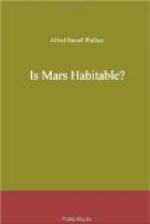“We have assumed, in our little calculation, that the entire contents of a polar hood turn to water; but in actual fact a considerable proportion of them must pass directly into vapour, omitting the intermediate stage. Even with us a large quantity of snow is removed aerially; and in the rare atmosphere of Mars this cause of waste must be especially effective. Thus the polar reservoirs are despoiled in the act of being opened. Further objections might be taken to Mr. Lowell’s irrigation scheme, but enough has been said to show that it is hopelessly unworkable.”
It will be seen that the writer of this article accepted the existence of water on Mars, on the testimony of Sir W. Huggins, which, in view of later observations, he has himself acknowledged to be valueless. Dr. Johnstone Stoney’s proof of its absence, derived from the molecular theory of gases, had not then been made public.
Description of some of the Canals.
At the end of his volume Mr. Lowell gives a large chart of Mars on Mercator’s projection, showing the canals and other features seen during the opposition of 1905. This contains many canals not shown on the map here reproduced (see frontispiece), and some of the differences between the two are very puzzling. Looking at our map, which shows the north-polar snow below, so that the south pole is out of the view at the top of the map, the central feature is the large spot Ascraeeus Lucus, from which ten canals diverge centrally, and four from the sides, forming wide double canals, fourteen in all. There is also a canal named Ulysses, which here passes far to the right of the spot, but in the large chart enters it centrally. Looking at our map we see, going downwards a little to the left, the canal Udon, which runs through a dark area quite to the outer margin. In the dark area, however, there is shown on the chart a spot Aspledon Lucus, where five canals meet, and if this is taken as a terminus the Udon canal is almost exactly 2000 miles long, and another on its right, Lapadon, is the same length, while Ich, running in a slightly curved line to a large spot (Lucus Castorius on the chart) is still longer. The Ulysses canal, which (on the chart) runs straight from the point of the Mare Sirenum to the Astraeeus Lucus is about 2200 miles long. Others however are even longer, and Mr. Lowell says: “With them 2000 miles is common; while many exceed 2500; and the Eumenides-Orcus is 3540 miles from the point where it leaves Lucus Phoeniceus to where it enters the Trivium Charontis.” This last canal is barely visible on our map, its commencement being indicated by the word Eumenides.




